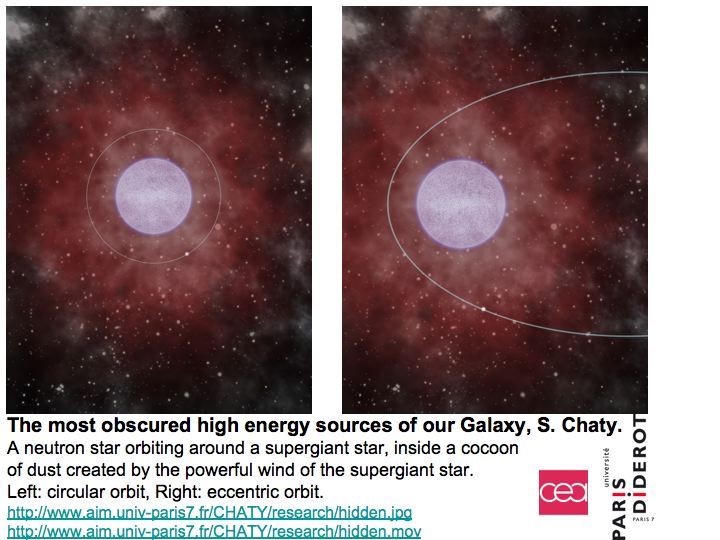New Discovery!!! The
most obscured celestial objects of our Galaxy:

SEE THE ANIMATION:
introduction (.mp3): english / français / español
animation (.mov): english
/ français / español
conclusion (.mp3): english
/ français / español
Original
NASA press release found at:
http://www.nasa.gov/centers/goddard/news/topstory/2007/gas_cocoon.html
”FOR RELEASE: 10:30 a.m. PST, February 5, 2007
SCIENTISTS FIND HIGH ENERGY SYSTEM HIDDEN IN "GAS COCOON"
Astronomers have found a new class of objects in space: a neutron star
orbiting inside a cocoon of cold gas and/or dust that hides a bloated
supergiant star. In a strange twist of fate, these objects may be
tremendously luminous, but the enshrouding cocoon absorbs almost all
their emission, making them nearly invisible to telescopes on Earth
until now.
These findings were presented on Feb. 5, 2007 by Dr. Sylvain Chaty of
the University Paris 7 and Service d’Astrophysique, CEA Saclay, Paris,
France, at the first Gamma Ray Large-Area Space Telescope (GLAST)
scientific Symposium meeting in Palo Alto, Calif.
This result, obtained through multi-wavelength observations, is of
special interest because it revolutionizes the view scientists have on
the formation, evolution, and fate of massive stars in close binary
(twin star) systems. Furthermore, this clearly demonstrates that the
GLAST satellite will likely discover more of these new and unexpected
celestial objects.
This new class of objects was discovered using the European
”INTErnational Gamma-Ray Astrophysics Laboratory” (INTEGRAL) satellite.
Twenty of these binary systems were found, with estimated distances
lying between 7,000 and 25,000 light years from Earth, putting them all
inside of our own Milky Way Galaxy. The nature of these sources was
revealed through multi-wavelength observations, mainly from optical to
mid-infrared (MIR) wavelengths, using European Southern Observatory
(ESO) facilities.
Scientists have found that most of these sources are made up of a
compact object orbiting a supergiant star, an enormous star with 30
times the Sun’s mass and 20 times its diameter. Stars like this eject a
huge amount of cold gas and/or dust at a rate equivalent to emitting
the mass of our Sun in just 100,000 years. This type of object is
called a High Mass X-ray Binary System (HMXB) and in most cases the
compact object is a neutron star, an object of about 1.4 solar masses
concentrated in a radius of only 10 kilometers (6.2 miles). Normally,
an object like this would be an intense source of X-rays as the
tremendous gravity and magnetic fields of the neutron star interact
with the dense gas and dust emitted from the more massive supergiant
star. However, for this new class of objects the cocoon of cold gas
and/or dust is so dense it absorbs most, but not quite all, of the high
energy X-rays. Only multi-wavelength observations, from X-rays to
infrared, were able to reveal the nature of such objects.
These systems seem to divide into two classes, likely depending on the
size and eccentricity (ellipticity) of the orbit of the neutron star
around its companion. In the first class of objects, such as IGR
J16318-4848, the neutron star orbits around the supergiant star along a
roughly circular orbit, like the Earth does around the Sun. However, in
this case, the orbit is far smaller: the distance from the neutron star
to the supergiant is less than the distance of Mercury from the
Sun—even though the supergiant star’s radius is 20 times bigger than
that of the Sun.
Since the cocoon of cold gas/dust totally blankets the whole system,
the neutron star stays permanently inside this dense cocoon, so there
is a persistent source of X-rays. But in the second class, such as IGR
J17544-2619, the orbit is more eccentric, and the neutron star crosses
only periodically into this dense cocoon of cold gas/dust covering the
supergiant star, causing intermittent emission of X-rays during that
time.
As Dr. Chaty, Associate Professor of Astrophysics at University Paris 7
and Service d’Astrophysique, CEA Saclay, France, points out, these
findings are important because “…until now only a few high energy
systems hosting supergiant stars were known, and none were exhibiting
such a high absorption. We now have an example where we know the extent
of the material causing this absorption, and also where it is coming
from.”
"This finding will help us to understand the formation, evolution and
fate of such massive stars in high energy binary systems. This result
demonstrates that astronomers will likely discover previously unknown
objects with the GLAST satellite, and that a multi-wavelength approach
can be decisive to unveil their nature.”
Further work, both observational and theoretical, is therefore needed
to study the environment of supergiant stars in binary star systems.
GLAST, with its sensitivity to very high-energy gamma rays, will
provide an ideal platform for follow-up observations. GLAST is slated
for launch in the fall of 2007. It is a collaborative effort between
NASA, the U.S. Department of Energy and institutions in France,
Germany, Japan, Italy and Sweden. General Dynamics has been chosen to
build the spacecraft.
Team led by S. Chaty and including F. Rahoui and P.-O. Lagage.
PRESS COVERAGE:
film+ explanation at http://www.astronomy.com/asy/default.aspx?c=ss&id=166
in french: Ciel et Espace:
http://www.cieletespace.fr/Actualites/524_un,objet,de,plus,au,bestiaire,celeste,.aspx
http://glast.sonoma.edu/resources/GLAST2007press
MEDIA HITS:
Scientists Find High Energy Systems Hidden in 'Gas Cocoon'
-and-
High-Energy 'Relic' Wind Reveals Past Behavior of Dead Stars
WEB FEATURES (RELEASE DATE: 02/06/07)
http://www.nasa.gov/centers/goddard/news/topstory/2007/gas_cocoon.html
http://www.nasa.gov/centers/goddard/news/topstory/2007/relic_wind.html
HITS UPDATED: 10 a.m. EST 2/8/07
SUMMARY: These web features received fair media coverage, mostly from
Web media.
Highlights included: EIN News, News Now, PhysNews.com, PhysOrg.com,
RedOrbit.com, Science Daily, Space Daily, and SpaceFlightNow.com.
International coverage: Canada, South Africa, United Kingdom.
A. Wire and Major Media Outlet Coverage:
DAILY ROTATION: http://www.dailyrotation.com/
EARTH CHANGES TV: http://www.earthchangestv.net/
EIN NEWS: http://www.einnews.com/germany/newsfeed-germany-accidents
MOREOVER: http://p.moreover.com/cgi-local/page?c=Oil+and+gas+news&o=rss
NEWS NOW (SOUTH AFRICA): http://www.newsnow.co.uk/newsfeed/?name=South+Africa
NEWSTER: http://www.newster.net/Newster/NewsStory.aspx?NewsID=561909&CategoryID=sci
PHYSNEWS: http://www.physnews.com/?page=4&category=2
PHYSORG.COM: http://www.physorg.com/news90001670.html
RED NOVA / ORBIT: http://www.redorbit.com/
ROJO: http://www.rojo.com/story/jzhu5q58qra2jWjY
ROOTLY: http://www.rootly.com/science/space_astronomy/Scientists_Find_High_Energy_Systems_Hidden_in_Gas_Cocoon/
SCIENCE DAILY: http://www.sciencedaily.com/releases/2007/02/070207194026.htm
SPACE DAILY: http://www.spacedaily.com/reports/High_Energy_Relic_Wind_Reveals_Past_Behavior_Of_Dead_Stars_999.html
SPACE FLIGHT NOW: http://www.spaceflightnow.com/news/n0702/06relic/
SPACER: http://spacer.com/
TOPIX.NET: http://www.topix.net/science/astronomy
UNEXPLAINED MYSTERIES: http://www.unexplained-mysteries.com/forum/index.php?showtopic=87779
